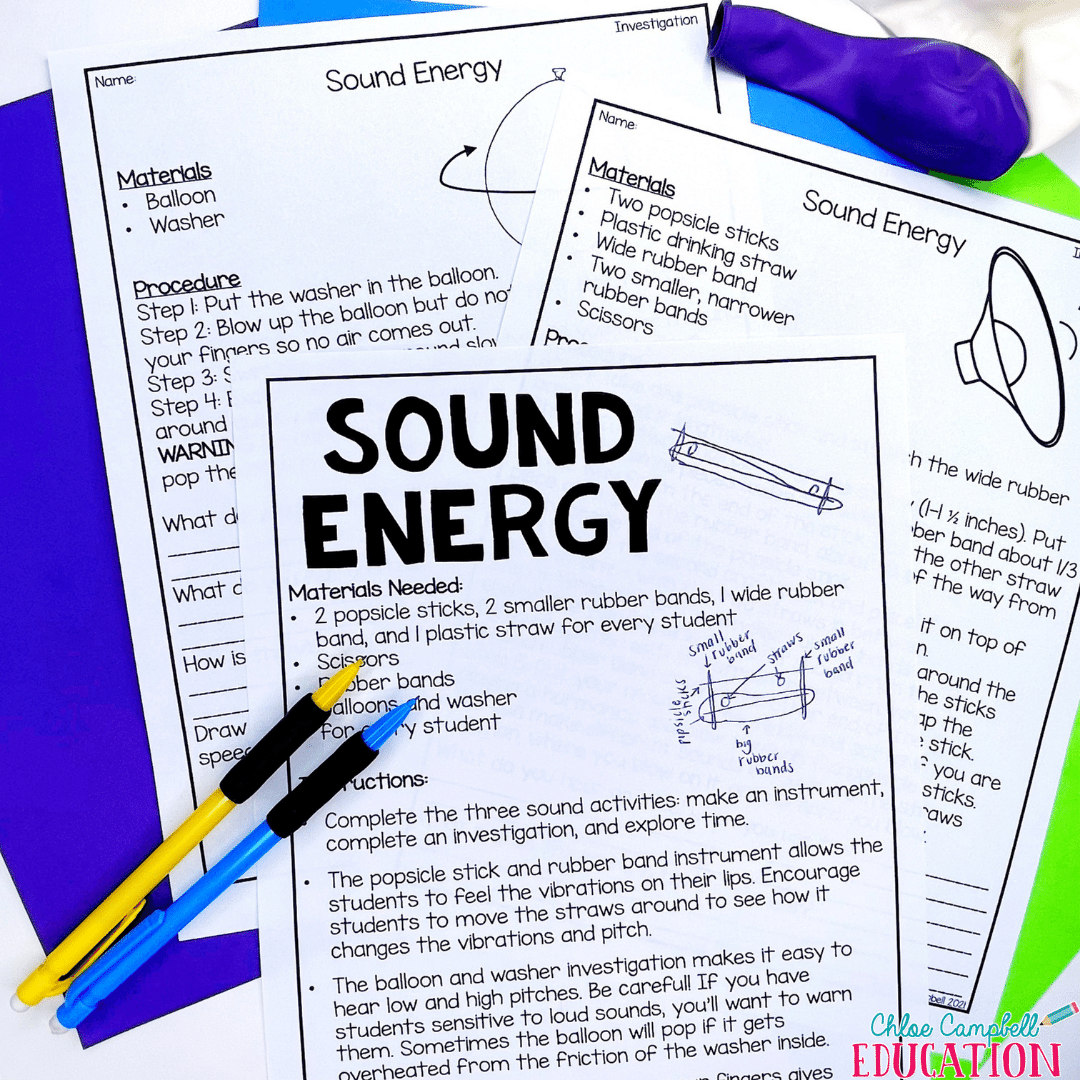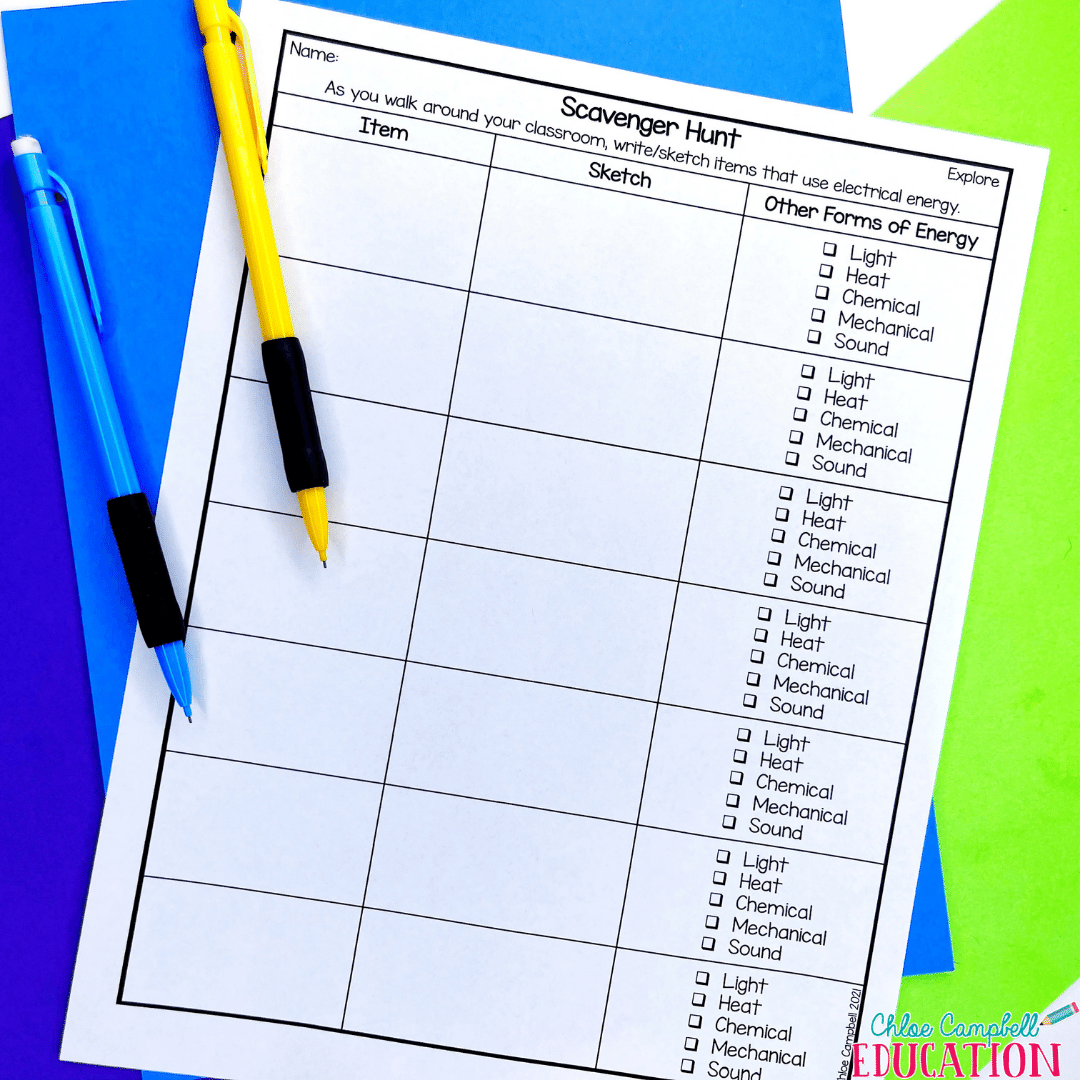Are you ready to introduce energy to your students but don’t quite know how to make it relatable and keep your lesson plans fun and engaging? Energy is all around us, from the light that shines in the classroom to the static you create walking across the carpet. Energy is a science that encompasses every bit of our daily life, usually going unnoticed. Your students are probably so used to seeing things use or produce energy but often don’t fully understand what is actually happening. Today, I’m sharing 4 strategies to help you create fun, relatable energy lesson plans!

Why Making Your Energy Lesson Plans Relatable is Important
Just like the weather, energy is a concept that many students experience all day, every single day without realizing it. Giving students the knowledge and understanding to recognize energy in their day-to-day routines will help them stay engaged and retain information. They will also enjoy pointing out how energy is working in various forms around the classroom.

I love helping make scientific concepts relatable to my students by giving them real-world examples and helping them experience science firsthand when possible. Showing them how the concepts they are learning about in class translate to the environment around them will hopefully help them appreciate what they are learning and show them just how important science is to our world.
Use Everyday Objects to Introduce Energy
A great way to introduce the concept of energy to students is by giving them specific examples of ordinary objects that use or produce energy. There are so many examples of different forms of energy that you can point out while in your classroom. Here are a few examples that you may not think of but will be easily relatable to your students.
The Mirror
Your students have probably looked into mirrors hundreds of times over their lifetime. Have they ever questioned how it is that they can see themselves, looking back at themselves? A mirror is just a common household item but reflects energy in the form of light!

Without light, a mirror wouldn’t work, but it’s not just the light that illuminates the room giving you the ability to see the mirror, it is the light that reflects back that gives you your reflection. Just as you could see on a calm pond, you are looking at the light reflecting off of an object back into your eyes.
A fun little exercise to do with your students is to take a walk around the classroom to find things that reflect light well enough to create a reflection. It is interesting to see that some objects that may seem reflective may not give off a good “mirror” image. Click here for a great video giving a simple explanation of how mirrors work and the history behind them.
The Guitar

We all have our favorite songs we like to listen to, and not all of them include a guitar. But they all need energy to exist. The guitar is an excellent way to see how energy can create the music you hear.
When we hear music, we don’t think of the literal waves flowing through the air to our ears, but only of the sound it makes. When you play or watch someone else play the guitar, you may not notice the strings’ vibration unless you pay very close attention. Here is a video perfectly demonstrating the vibrations of each string and how they differ from the others because of their size. Granted, the camera’s frame rate contributes to the visual of the vibrations, but it is a great way to show someone just how sound waves work.
A great activity that you can do in the classroom involving sound energy is to have your students grab a pencil and create “instruments”. Take the eraser end of the pencil and tap it on random objects to see what sound it produces. Have your students take note of what objects make deep bass sounds or a higher pitch sound. Also, ask them to take into account the volume of an object and the material that it is made of to hypothesize what sound it might make.
Ways to Keep Energy Lesson Plans Relatable
Now that you have some great examples of energy that your students will be familiar with, you’re probably wondering how to take your energy lessons plans and keep them engaging and relatable. I use many different instruction techniques in my classroom and here are just a few of my favorites to keep the energy flowing and keep those connections strong!
Use Interactive Notes
I use interactive notes for so many topics and units in my classroom. They help students understand and retain information much better because they have an interactive component. You can use interactive notes during your lesson or as a study tool. They work great as standalone resources or you can have your students create an interactive science notebook using their notes. (I especially love using them with my weather lesson plans!)
Allowing students to “create” the notes and add information helps them develop a deeper level of learning. This hands-on strategy is easy to implement, especially with printable note templates. I have included several foldable note templates in my Forms of Energy bundle. Simply print, hand out, and allow your students to assemble and record information.
Simple Investigations & Experiments

A great way to keep students engaged and excited about the forms of energy is to complete some easy scientific investigations. Having students roll up their sleeves and complete experiments is the best way for them to understand the forms of energy first-hand.
If you’re like me, you’re probably trying to fit a lot of great information and activities into your energy lesson plans. Adding experiments may seem like it will be too much or create a time crunch in your plans. The key is to do simple, easy-to-follow energy investigations that will easily “click” for your students and give them a great example of energy.
The Forms of Energy Bundle includes plenty of simple investigations and experiments with supply lists and easy-to-follow instructions. There are also observation and conclusion templates included so you can easily implement these fun activities into your plans.
A few of my favorite investigations to complete with students are the sound energy investigation and static electricity explore activity. Here’s the list of those included in the bundle:
- How Does Light Travel? Investigation
- Heat/Thermal Energy Investigation
- Sound Energy Investigation
- Sound Energy Explore
- Static Electricity Explore
- Static Electricity Investigation
- Marshmallow Catapults Experiment
- Electrical Energy Scavenger Hunt Explore
- Electrical Energy Investigation
- Chemical Energy Investigation
Real-World Applications
I mentioned the mirror and guitar above and shared how you can make energy relatable to your students by sharing how these objects work. There are so many other real-world applications of energy all around us.
Challenge your students to find different forms of energy around them in the classroom. You could create a chart showing how many examples of each type of energy you can locate in your room.
You can also give your students real-world situations and have them use critical thinking skills to explain how energy is used. The bundle includes real-life application pages for :
- Static Electricity
- Mechanical Energy
- Electrical Energy
- Chemical Energy
- Energy Transfers
These pages help students relate the concept of energy to events and situations they’ve likely encountered or are familiar with. This type of exercise really helps students relate energy to their everyday life.
An Energy Scavenger Hunt
After introducing the different forms of energy and how they can be found all around us, consider sending your students on a scavenger hunt! This is such a fun activity! It will get your kids up and moving around the room in search of different forms of energy.
You can create an energy scavenger hunt by type of energy or type of object. The scavenger hunt checklist included in the Forms of Energy bundle doesn’t list specific items for the students to find. It gives them the opportunity to locate and identify different forms of energy in objects around them. This encourages them to question many different objects and use what they’ve learned about energy to decide if an object is using or creating certain types of energy.
Forms of Energy Bundle
If you’re looking for an easy, low-prep way to teach energy to your students, be sure to check out my Forms of Energy Bundle. This bundle includes no prep activities and worksheets that are easy to use and your students will love.
Forms of Energy Activity Topics Covered:
- Light Energy
- Heat Energy
- Sound Energy
- Mechanical Energy
- Electrical Energy and Circuits
- Chemical Energy
- Electrical Conductors and Insulators
- Static Electricity
- Potential and Kinetic Energy
- Energy Transfers
I love this bundle because you can use it as one large energy unit. You can also break it apart into separate, smaller units. I’ve also included a supply list, so you can be prepared to allow your students to get hands-on with energy and dig into the investigations and experiments!
How do you make forms of energy relatable to your students? Do you use any of the strategies I’ve shared above? I’d love to hear your thoughts!







Leave a Reply